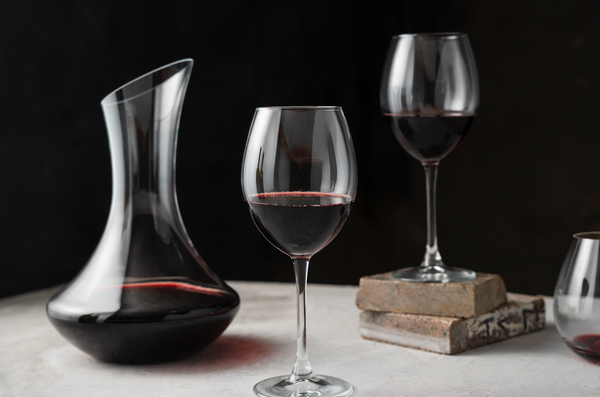
Why Does Wine Need to Breathe?
If you’ve ever heard the phrase “let the wine breathe” and wondered what it means, you’re not alone. Allowing wine to “breathe” is a common practice among wine enthusiasts, but why is it necessary? Does it really make a difference in how the wine tastes? The answer is yes, and here’s why letting your wine breathe can elevate your wine-drinking experience.
1. What Does It Mean for Wine to Breathe?
When people talk about letting wine breathe, they’re referring to the process of exposing the wine to air, specifically oxygen. This exposure to oxygen can soften the wine’s tannins, enhance its aromas, and bring out its full flavor profile. Essentially, allowing wine to breathe gives it time to “open up” and release the complex layers of flavors and scents that may be muted straight out of the bottle.
2. The Role of Oxygen in Wine
Oxygen plays a crucial role in the way wine evolves over time. When you open a bottle of wine, the oxygen that comes into contact with the wine begins a process known as oxidation. This process can be beneficial in small amounts, helping to enhance certain characteristics of the wine, such as:
-
Softening Tannins: In red wines, tannins (the compounds that give wine structure and astringency) can sometimes be harsh when first poured. A little exposure to air can help soften these tannins, making the wine smoother and more enjoyable to drink.
-
Enhancing Aromas: Oxygen helps release the volatile compounds in wine, which are responsible for its aroma. Letting the wine breathe allows these compounds to come to the surface, intensifying the wine’s fragrance.
-
Balancing Flavors: Especially in young wines, allowing the wine to breathe can help integrate and balance flavors, making the wine taste more harmonious.
3. Which Wines Benefit from Breathing?
Not all wines need to breathe, but here are some general guidelines:
-
Red Wines: Most red wines, particularly full-bodied varieties like Cabernet Sauvignon, Syrah, and Merlot, benefit from breathing. These wines often have higher tannin levels that soften with exposure to air.
-
Young Wines: Young, robust red wines that are high in tannins and acidity often improve with a little air exposure. Breathing helps mellow these characteristics, making the wine more approachable.
-
Aged Wines: Older wines, especially those that have been stored for a decade or more, can benefit from brief aeration to allow any volatile compounds to dissipate. However, be cautious as some older wines can lose their delicate aromas if exposed to too much air for too long.
-
White Wines: Most white wines don’t require breathing, but fuller-bodied whites, such as Chardonnay or Viognier, can benefit from a short exposure to air. It helps to soften the oak influence and bring out the wine’s fruity and floral notes.
-
Sparkling Wines: Sparkling wines like Champagne generally do not benefit from breathing, as exposure to air will cause them to lose their bubbles and freshness.
4. How to Let Wine Breathe

There are different ways to let wine breathe, depending on how much time you have and the type of wine you’re drinking:
-
Decanting: Pouring the wine into a decanter exposes a larger surface area of the wine to oxygen, speeding up the breathing process. Decanting is especially useful for young red wines or wines with sediment. For most wines, 30 minutes to an hour in a decanter is ideal.
-
Swirling the Glass: If you don’t have time to decant, simply swirling the wine in your glass can also help it breathe. Swirling exposes the wine to air and releases its aromas more quickly.
-
Opening the Bottle: Some people believe that simply opening the bottle and letting it sit will allow the wine to breathe, but this method is less effective. The narrow neck of the bottle limits the amount of wine exposed to air, so it’s better to pour the wine into a glass or decanter.
5. How Long Should Wine Breathe?
The amount of time a wine needs to breathe depends on the type of wine and its characteristics:
-
Young Red Wines: Can benefit from 30 minutes to 2 hours of breathing time to allow the tannins to soften and the flavors to develop.
-
Full-Bodied Whites: Typically need about 15-30 minutes of air exposure to balance their flavors.
-
Aged Wines: Should be tasted after 10-15 minutes of air exposure to see how they evolve. Be cautious with older wines, as too much air can cause them to lose their delicate aromas.
-
Lighter Reds and Whites: Wines like Pinot Noir and Sauvignon Blanc don’t need much breathing time, as they are typically lighter in tannins and more delicate in flavor.
6. Do All Wines Need to Breathe?
Not all wines benefit from breathing. Fresh, light wines that are meant to be enjoyed young—such as Beaujolais Nouveau, Riesling, or light rosé wines—typically don’t need aeration. Their flavors are meant to be bright, fresh, and lively right from the bottle.
Conclusion
Letting wine breathe is a simple way to elevate your wine experience, especially for fuller-bodied and tannic wines. By giving your wine a little time to interact with oxygen, you allow its flavors to open up, its tannins to soften, and its aromas to shine. Whether you’re decanting a robust red or simply swirling your glass, the right amount of breathing time can turn a good bottle into a great one.
To ensure your wine is always at its best, proper storage is key. A wine fridge maintains the ideal temperature and humidity for your wine, preserving it until you’re ready to open it. Explore our range of wine fridges at winefridge.sg and give your wine the perfect environment to age gracefully.

